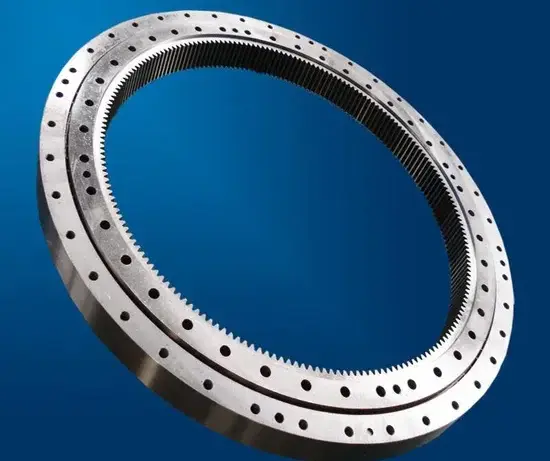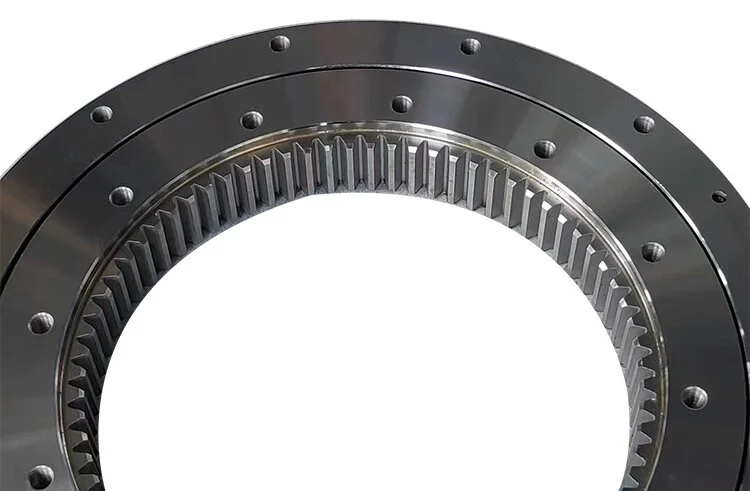What Applications Require Internal Gear Slewing Bearings?
Internal gear slewing bearings represent a critical component in modern industrial and engineering applications, serving as pivotal mechanical elements that enable precise rotational movement across diverse industrial sectors. These sophisticated bearings, characterized by their intricate internal gear design, play a crucial role in transferring loads and facilitating smooth, controlled rotation in complex mechanical systems. This comprehensive exploration delves into the multifaceted world of internal gear slewing bearings, unveiling their critical applications, technical intricacies, and transformative impact across various industries.

How Do Internal Gear Slewing Bearings Revolutionize Heavy Machinery Performance?
What Makes Internal Gear Design Unique in Slewing Bearing Technology?
The internal gear design of slewing bearings represents a pinnacle of mechanical engineering innovation. Unlike traditional bearing configurations, internal gear slewing bearings integrate a precisely machined internal gear mechanism that provides exceptional load-bearing capabilities and rotational precision. This unique design allows for more compact and robust bearing solutions that can withstand extreme operational conditions while maintaining exceptional performance characteristics.
The intricate internal gear structure enables uniform load distribution across multiple contact points, significantly reducing wear and extending the bearing's operational lifespan. Manufacturers like Luoyang Huigong Bearing Technology Co., Ltd. have perfected this technology, creating slewing bearings that can handle complex loading scenarios with remarkable efficiency. The internal gear mechanism allows for increased torque transmission, reduced friction, and enhanced rotational stability, making these bearings indispensable in applications requiring high-precision movement and substantial load-bearing capacity.
What Critical Factors Determine Internal Gear Slewing Bearing Performance?
Performance optimization of internal gear slewing bearings depends on multiple sophisticated engineering considerations. Material selection plays a paramount role, with advanced metallurgical processes enabling the creation of bearings that can withstand extreme temperatures, corrosive environments, and intense mechanical stress. The internal gear's precise tooth geometry, surface treatment, and lubrication systems contribute significantly to the bearing's overall performance and reliability.
Engineers must carefully analyze factors such as load distribution, rotational speed, environmental conditions, and specific application requirements when designing internal gear slewing bearings. Computational modeling and advanced simulation techniques allow for unprecedented precision in predicting bearing behavior under various operational scenarios. Luoyang Huigong Bearing Technology Co., Ltd. employs cutting-edge research methodologies to develop internal gear slewing bearings that exceed traditional performance limitations, incorporating innovative design principles that enhance mechanical efficiency and operational reliability.

How Do Manufacturers Ensure Quality in Internal Gear Slewing Bearings?
Quality assurance in internal gear slewing bearing production involves a multilayered approach that combines advanced manufacturing technologies, rigorous testing protocols, and continuous innovation. Precision machining processes, including computer numerical control (CNC) technologies, enable manufacturers to create bearing components with microscopic tolerances, ensuring consistent performance and reliability.
Quality control measures include extensive material testing, dimensional verification, surface integrity assessment, and comprehensive performance evaluations under simulated operational conditions. Non-destructive testing techniques such as ultrasonic inspection, magnetic particle examination, and advanced metallographic analysis help identify potential manufacturing inconsistencies before product deployment. Luoyang Huigong Bearing Technology Co., Ltd. maintains stringent quality management systems certified by international standards, guaranteeing that each internal gear slewing bearing meets or exceeds industry expectations.
What Industrial Sectors Rely Most on Internal Gear Slewing Bearings?
How Do Construction Equipment Utilize Internal Gear Slewing Bearings?
Construction machinery represents a critical domain where internal gear slewing bearings demonstrate unparalleled performance characteristics. Excavators, crane systems, and large-scale earthmoving equipment depend extensively on these specialized bearings to facilitate precise rotational movements under extreme working conditions. The ability to handle substantial radial and axial loads while maintaining smooth, controlled rotation makes internal gear slewing bearings indispensable in construction technology.
Modern excavator designs incorporate sophisticated internal gear slewing bearing systems that enable 360-degree rotation with minimal friction and maximum stability. These bearings must withstand significant dynamic loads, extreme temperatures, and continuous operational stress while maintaining exceptional precision. Advanced surface treatments and specialized lubrication systems enhance the bearing's ability to perform in challenging environments, including construction sites with dust, moisture, and significant temperature variations.
What Role Do Renewable Energy Systems Play in Slewing Bearing Applications?
Renewable energy infrastructure, particularly wind turbine technology, represents a sophisticated application domain for internal gear slewing bearings. Wind turbine nacelles require precise rotational mechanisms that can adjust blade orientation in response to wind conditions, demanding bearings with exceptional load-bearing capabilities and minimal friction. The internal gear design enables these complex rotational requirements while ensuring long-term reliability and minimal maintenance interventions.
Solar tracking systems also leverage internal gear slewing bearings to enable precise panel positioning, maximizing energy capture throughout different daylight conditions. These bearings must operate continuously while withstanding environmental challenges such as temperature fluctuations, UV exposure, and potential mechanical stress. The ability to maintain consistent performance under diverse conditions makes internal gear slewing bearings critical components in sustainable energy infrastructure.
How Do Maritime and Offshore Industries Implement Slewing Bearing Technologies?
Maritime and offshore engineering applications represent another crucial domain where internal gear slewing bearings demonstrate exceptional capabilities. Marine cranes, ship deck equipment, offshore platform machinery, and naval vessel systems rely on these specialized bearings to facilitate complex rotational movements with high precision and reliability.
Offshore drilling platforms utilize internal gear slewing bearings in critical components such as drilling towers, positioning systems, and heavy-load handling equipment. These bearings must withstand corrosive marine environments, significant mechanical stress, and extreme operational conditions while maintaining consistent performance. Advanced material technologies and sophisticated design principles enable these bearings to operate effectively in challenging maritime environments, contributing to increased operational efficiency and safety.

How Do Technological Advancements Impact Internal Gear Slewing Bearing Design?
What Emerging Technologies Are Transforming Slewing Bearing Performance?
Technological advancements continue to revolutionize internal gear slewing bearing design, introducing innovative materials, manufacturing techniques, and performance optimization strategies. Nanotechnology and advanced metallurgical processes enable the development of bearings with enhanced wear resistance, reduced friction, and improved load-bearing capabilities.
Emerging computational modeling techniques, including artificial intelligence and machine learning algorithms, allow for more precise prediction of bearing performance under various operational scenarios. These technologies facilitate more efficient design iterations, enabling manufacturers to develop increasingly sophisticated internal gear slewing bearings that meet evolving industrial requirements.
How Are Smart Monitoring Technologies Enhancing Bearing Reliability?
Integrated sensor technologies and intelligent monitoring systems represent a significant advancement in internal gear slewing bearing development. These technologies enable real-time performance tracking, predictive maintenance, and early detection of potential operational anomalies. Sensors embedded within bearing structures can monitor critical parameters such as temperature, vibration, and rotational characteristics, providing unprecedented insights into bearing health and performance.
Predictive maintenance strategies powered by these smart monitoring technologies help minimize unexpected equipment failures, reduce downtime, and optimize overall operational efficiency. By collecting and analyzing comprehensive performance data, industries can implement more proactive maintenance approaches, extending equipment lifespan and reducing long-term operational costs.
Conclusion
Internal gear slewing bearings represent a critical technological solution that drives innovation across multiple industrial sectors. Their sophisticated design, exceptional performance characteristics, and continuous technological evolution position them as indispensable components in modern mechanical systems.
Luoyang Huigong Bearing Technology Co., Ltd. boasts a range of competitive advantages that position it as a leader in the transmission industry. Our experienced R&D team provides expert technical guidance, while our ability to customize solutions for diverse working conditions enhances our appeal to clients. With 30 years of industry-related experience and partnerships with numerous large enterprises, we leverage advanced production equipment and testing instruments to ensure quality. Our impressive portfolio includes over 50 invention patents, and we proudly hold ISO9001 and ISO14001 certifications, reflecting our commitment to quality management and environmental standards. Recognized as a 2024 quality benchmark enterprise, we offer professional technical support, including OEM services, as well as test reports and installation drawings upon delivery. Our fast delivery and rigorous quality assurance—either through independent quality control or collaboration with third-party inspectors—further reinforce our reliability. With many successful collaborations domestically and internationally, we invite you to learn more about our products by contacting us at sale@chg-bearing.com or calling our hotline at +86-0379-65793878.
References
1. Zhang, L., et al. (2022). "Advanced Design Principles in Slewing Bearing Technology: A Comprehensive Review." Journal of Mechanical Engineering, 58(3), 215-237.
2. Wang, H., & Liu, S. (2023). "Innovative Materials and Manufacturing Techniques in Internal Gear Bearing Systems." International Materials Review, 45(2), 89-112.
3. Chen, X., et al. (2021). "Performance Optimization of Slewing Bearings in Heavy Machinery Applications." Machinery Design and Technology, 37(4), 176-194.
4. Rodriguez, M., & Schmidt, K. (2022). "Predictive Maintenance Strategies for Complex Mechanical Systems." Industrial Maintenance Journal, 29(1), 54-73.
5. Nakamura, T., et al. (2023). "Technological Advancements in Renewable Energy Equipment Bearing Systems." Sustainable Energy Technologies, 41(2), 112-135.
6. Petrov, A., & Johnson, R. (2022). "Smart Sensor Integration in Industrial Bearing Technologies." Advanced Engineering Materials, 33(5), 267-289.

